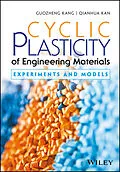New contributions to the cyclic plasticity of engineering materials
Written by leading experts in the field, this book provides an authoritative and comprehensive introduction to cyclic plasticity of metals, polymers, composites and shape memory alloys. Each chapter is devoted to fundamentals of cyclic plasticity or to one of the major classes of materials, thereby providing a wide coverage of the field.
The book deals with experimental observations on metals, composites, polymers and shape memory alloys, and the corresponding cyclic plasticity models for metals, polymers, particle reinforced metal matrix composites and shape memory alloys. Also, the thermo-mechanical coupled cyclic plasticity models are discussed for metals and shape memory alloys.
Key features:
- Provides a comprehensive introduction to cyclic plasticity
- Presents Macroscopic and microscopic observations on the ratchetting of different materials
- Establishes cyclic plasticity constitutive models for different materials.
- Analysis of cyclic plasticity in engineering structures.
This book is an important reference for students, practicing engineers and researchers who study cyclic plasticity in the areas of mechanical, civil, nuclear, and aerospace engineering as well as materials science.
Autorentext
Professor Guozheng Kang achieved his Bachelor Degree from Tsinghua University, China in 1992, and then he obtained his Master and PhD degrees from Southwest Jiaotong University, China in 1994 and 1997, respectively. Kang joined Southwest Jiaotong University, China as a lecturer in 1997 and was promoted to associate professor and professor in 2003 and 2005, respectively. He has received the "Alexander von Humboldt Fellowship", "Outstanding Young Investigator Award of NSFC", "Cheung Kong Chair Professor of MOE, China", and "Program for Ten Thousands Talent, China". His research interests focus on the cyclic constitutive models of advanced materials, fatigue and fracture, and meso-mechanics analysis of composites. Kang has published 5 books, 4 book chapters and 130 international journal papers. Currently, he is a member of the editorial board for five international peer-reviewed journals, including the International Journal of Plasticity, ZAMM-Zeitschrift fur Angewandte Mathematik und Mechanik, Acta Mechanica Sinica and the Journal of the Mechanical Behavior of Materials.
Dr. Qianhua Kan obtained his Bachelor Degree in Civil Engineering with first class honors from Zhengzhou University in 2002. He obtained his Master Degree in Solid Mechanics from Southwest Jiaotong University in 2005 and his PhD degree from the same University in 2009. Following this, Dr. Kan joined Southwest Jiaotong University as a lecturer in 2009 and was promoted to associate professor in 2012. Dr. Kan visited Monash University (Australia) as an award holder of the Endeavour Research Fellowship for six months in 2011. His research interests include fatigue failures of smart materials, wheel-rail contact, biomechanics and finite element analysis. Dr. Kan has been awarded 5 research grants from NSFC and National Key Laboratories since 2009. Currently, he is supervising and co-supervising 13 postgraduate research students. Dr. Kan has published 5 books, 2 book chapters and 45 international journal papers.
Inhalt
Introduction 1
I.1 Monotonic Elastoplastic Deformation 1
I.2 Cyclic Elastoplastic Deformation 3
I.2.1 Cyclic Softening/Hardening Features 3
I.2.2 Mean Stress Relaxation 6
I.2.3 Ratchetting 7
I.3 Contents of This Book 9
References 10
1 Fundamentals of Inelastic Constitutive Models 13
1.1 Fundamentals of Continuum Mechanics 13
1.1.1 Kinematics 13
1.1.2 Definitions of Stress Tensors 15
1.1.3 Frame-Indifference and Objective Rates 16
1.1.4 Thermodynamics 17
1.1.4.1 The First Thermodynamic Principle 17
1.1.4.2 The Second Thermodynamic Principle 17
1.1.5 Constitutive Theory of Solid Continua 18
1.1.5.1 Constitutive Theory of Elastic Solids 18
1.1.5.2 Constitutive Theory of Elastoplastic Solids 19
1.2 Classical Inelastic Constitutive Models 22
1.2.1 J2 Plasticity Model 23
1.2.2 Unified Visco-plasticity Model 24
1.3 Fundamentals of Crystal Plasticity 25
1.3.1 Single Crystal Version 25
1.3.2 Polycrystalline Version 27
1.4 Fundamentals of Meso-mechanics for Composite Materials 28
1.4.1 Eshelby's Inclusion Theory 29
1.4.2 Mori-Tanaka's Homogenization Approach 30
References 32
2 Cyclic Plasticity of Metals: I. Macroscopic and Microscopic Observations and Analysis of Micro-mechanism 35
2.1 Macroscopic Experimental Observations 35
2.1.1 Cyclic Softening/Hardening Features in More Details 35
2.1.1.1 Uniaxial Cases 35
2.1.1.2 Multiaxial Cases 43
2.1.2 Ratchetting Behaviors 47
2.1.2.1 Uniaxial Cases 48
2.1.2.2 Multiaxial Cases 62
2.1.3 Thermal Ratchetting 75
2.2 Microscopic Observations of Dislocation Patterns and Their Evolutions 77
2.2.1 FCC Metals 80
2.2.1.1 Uniaxial Case 80
2.2.1.2 Multiaxial Case 86
2.2.2 BCC Metals 95
2.2.2.1 Uniaxial Case 95
2.2.2.2 Multiaxial Case 103
2.3 Micro-mechanism of Ratchetting 111
2.3.1 FCC Metals 111
2.3.1.1 Uniaxial Ratchetting 111
2.3.1.2 Multiaxial Ratchetting 114
2.3.2 BCC Metals 115
2.3.2.1 Uniaxial Ratchetting 115
2.3.2.2 Multiaxial Ratchetting 117
2.4 Summary 118
References 119
3 Cyclic Plasticity of Metals: II. Constitutive Models 123
3.1 Macroscopic Phenomenological Constitutive Models 124
3.1.1 Framework of Cyclic Plasticity Models 124
3.1.1.1 Governing Equations 124
3.1.1.2 Brief Review on Kinematic Hardening Rules 126
3.1.1.3 Combined Kinematic and Isotropic Hardening Rules 131
3.1.2 Viscoplastic Constitutive Model for Ratchetting at Elevated Temperatures 136
3.1.2.1 Nonlinear Kinematic Hardening Rules 136
3.1.2.2 Nonlinear Isotropic Hardening Rule 137
3.1.2.3 Verification and Discussion 138
3.1.3 Constitutive Models for Time-Dependent Ratchetting 144
3.1.3.1 Separated Version 146
3.1.3.2 Unified Version 152
3.1.4 Evaluation of Thermal Ratchetting 161
3.2 Physical Nature-Based Constitutive Models 163
3.2.1 Crystal Plasticity-Based Constitutive Models 163
3.2.1.1 Single Crystal Version 163
3.2.1.2 Application to Polycrystalline Metals 167
3.2.2 Dislocation-Based Crystal Plasticity Model 175
3.2.2.1 Single Crystal Version 175
3.2.2.2 Verification and Discussion 177
3.2.3 Multi-mechanism Constitutive Model 183
3.2.3.1 2M1C Model 187
3.2.3.2 2M2C Model 188
3.3 Two Applications of Cyclic Plasticity Models 189
3.3.1 Rolling Contact Fatigue Analysis of Rail Head 189
3.3.1.1 Experimental and Theoretical Evaluation to the Ratchetting of Rail Steels 190
3.3.1.2 Finite Element Simulations 194
3.3.2 Bending Fretting Fatigue Analysis of Axles in Railway Vehicles 197
3.3.2.1 Equivalent Two-Dimensional Finite Element Model 199
3.3.2.2 Finite Element Simulation to Bending Fretting Process 201
3.3.2.3 Predictions to Crack Initiation Location and Fretting Fatigue Life 203
3.4 Summary 209
References 211
4 Thermomechanically Coupled Cyclic Plasticity of Metallic Materials at Finite Strain 219
4.1 Cyclic Plasticity Model at Finite Strain 221
4.1.1 Framework of Finite Elastoplastic Constitutive Model 221
4.1.1.1 Equations of Kinematics 221
4.1.1.2 Consti…
